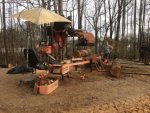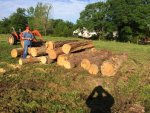Living in the middle of big timber country, I gotten to tune my lumber knowledge quite a bit.
I also have 40 thousand some odd trees on our place, douglas fir, tamarack (western larch), ponderosa pine, white pine, spruce, cedar, poplar, birch, hemlock, and others.
7 years ago we logged out 8 semi loads of Tamarack, Douglas fir, and hemlock, and 2 semi loads of birch. and that was just to clean up some areas.
One thing I can tell ya about working with timber, is it's not easy, clean, safe or cheap to do.
The cost of milling lumber is not really as cheap as you say because of many more factors.
Included in that final price,
Time (labor), fuel and expenses to fell, prep, retrieve, and move the logs.
Time, fuel and expense of dealing with the logs to get them to and on the mill.
Time, fuel, and expense to sort stack, cure / dry the "finished" lumber,
And finally the time, fuel, and expense to deal with the scrap and cleanup.
Sadly all this adds up to somewhere around the range of $1.50 to $3 per board foot depending on the working conditions and size / weight of the logs that you're trying to process.
So in this case they were cull logs, so your cutting / milling was higher loss than good mill logs, what would you say 20% loss?
Do you only get paid for good wood or anything you cut?
Most get paid for cuts, even if the wood ends up bad in any way.
They are only air drying and not being kiln dried so you'll have loss there, Figure about 20% due to warpage and twist.
What size do you mill them to? true width, shrinkage width, or planer width.
I love mill run lumber, but it's brutal to work with, you'll end up with some wicked splinter possibilities, that's one of the reason production lumber is crimped or has eased edges (rounds edges).
Also building some barns, sheds, fence, other projects with rough milled lumber is fine, but anything that will be structurally inspected, this will not pass.








